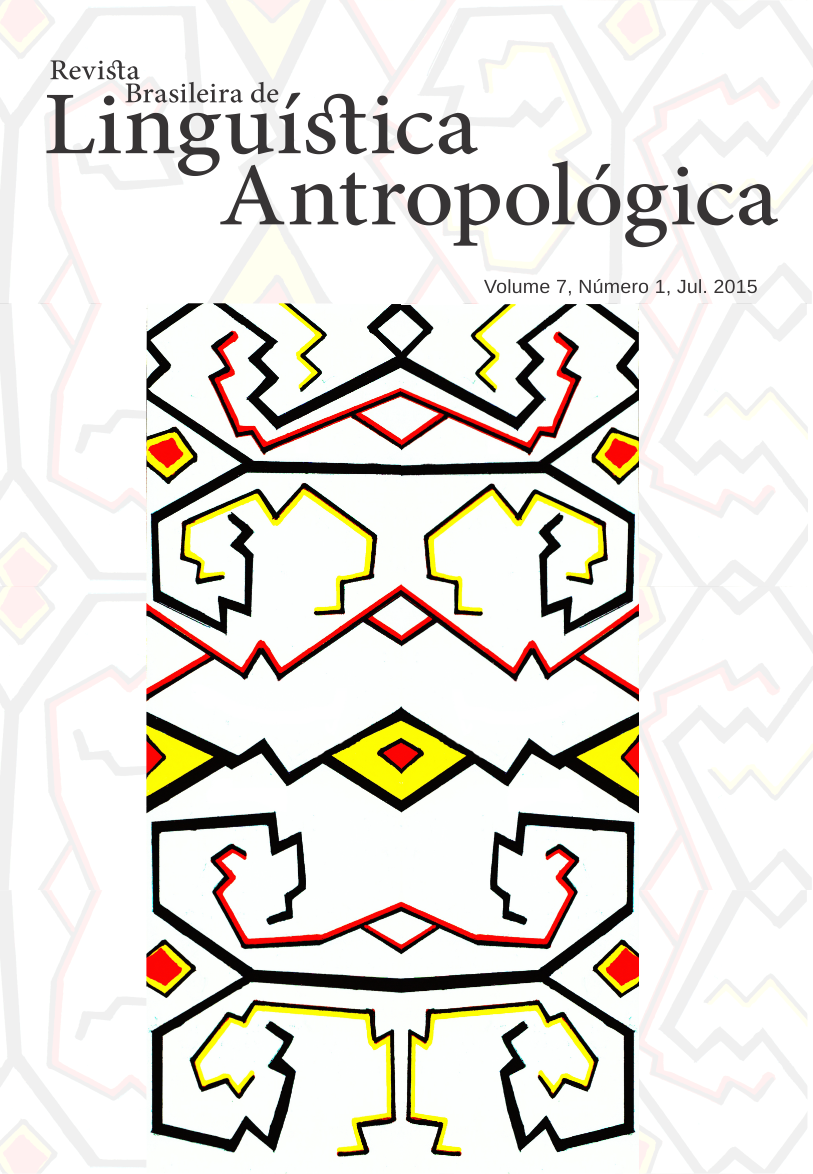Metáfora, metonimia y blending en construcciones ditransitivas del kamaiurá
DOI:
https://doi.org/10.26512/rbla.v7i1.16290Keywords:
Linguística AntropológicaAbstract
En este trabajo presentamos el análisis conceptual de algunas construcciones gramaticales del kamaiurá, lengua indígena brasileña, perteneciente al grupo étnico-lingüístico tupiguaraní del Alto Xingú. Los casos analizados revelan una alta complejidad semántica resultante, especialmente, de la integración (blending) de la metáfora REALIZAR UNA ACCIÓN ES TRANSMITIR UNA PARTE DEL CUERPO y de la metonimia PARTE DEL CUERPO POR LA ACCIÓN, para conceptuar acciones físicas y perceptuales/cognitivas. A diferencia de muchas lenguas europeas, la combinación de estos dos elementos conceptuales es utilizada en Kamaiurá tanto para la conceptuación de acciones abstractas (‘yo te mando mi ojo’ = yo me acuerdo de ti) como de acciones concretas (‘yo te mando mi brazo’ = yo te abrazo). Los datos presentados muestran además la gran importancia cultural que posee en kamaiurá el cuerpo humano como dominio fuente para la configuración de la estructura conceptual codificada por la gramática.Downloads
References
Al-Adaileh, Bilal and Renad Abbadi. 2012. The pragmatic implications of metonymical body-based idioms in Jordanian Arabic, Argumentum 8:73-91.
Barcelona, Antonio. 2003. Introduction: The Cognitive Theory of Metaphor and Metonymy, in: Antonio Barcelona (Ed), Metaphor and Metonymy at the Crossroads. Berlin/New York: Mouton de Gruyter, pp. 1-28.
Brown, Roger. 1965. Social psychology. New York: Free Press.
Croft, William. 2001. Radical Construction Grammar. Syntactic Theory in Typological Perspective. Oxford: OUP.
Delbecque, Nicole, and Béatrice Lamiroy. 1996. Towards a typology of the Spanish dative. In W. Van Belle and W. Van Langendonck (Eds.), The dative, vol. 1. Amsterdam & Philadelphia: John Benjamins, pp. 71-117.
Fauconnier, Gilles. 1997. Mappings in Language and Thought. Cambridge: Cambridge University Press.
Fauconnier, Gilles, and Mark Turner. 2002. The way we think: conceptual blending and the mind’s hidden complexities. New York: Basic Books.
Gibbs, Raymond. 2005. Embodiment and Cognitive Science. Cambridge: CUP.
Gibbs, Raymond W. and Nicole L. Wilson. 2002. Bodily Action and Metaphorical Meaning. Style 36(3):524-541.
Goldberg, Adele. E. 1992. The inherent semantics of argument structure: the case of the English ditransitive construction. Cognitive Linguistics 3:37-74.
______. 1995. Constructions: a Construction Grammar approach to argument structure. Chicago: University of Chicago Press.
Grady, Joseph E. 1997. Foundations of meaning: primary metaphors and primary scenes. Unpublished PhD dissertation. University of Berkeley.
Hollmann, Willem. 2007. From language-specific constraints to implicational universals: a cognitive-typological view of the dative alternation. Functions of Language 14(1):57-78.
Huelva Unternbäumen, Enrique. 2010. The complex domain matrix of ditransitive constructions. Constructions 1, 11 May 2010, online: <http://elanguage.net/journals/constructions/article/view/749>.
Huelva Unternbäumen, Enrique. 2015. From primary metaphors to the complex semantic pole of grammatical constructions. Language and Cognition 7:68-97.
Kövecses, Zoltan. 2005. Metaphor in Culture. Universality and Variation. Cambridge: CUP.
Kövecses, Zoltan. 2010. Metaphor. A Practical Introduction. Oxford: OUP.
Lakoff, George. 1987. Women, fire, and dangerous things: what categories reveal about the mind. Chicago & London: University of Chicago Press.
Lakoff, George, and Mark Johnson. 1999. Philosophy in the flesh: the embodied mind and its challenge to Western thought. New York: Basic Books.
Langacker, Ronald W. 2008. Cognitive Grammar: a basic introduction. Oxford: Oxford University Press.
Malchukov, Andrej; Martin Haspelmath and Bernard Comrie (Eds.) 2010. Studies in ditransitive constructions: a comparative Handbook. Berlin & New York: de Gruyter.
Newman, John. 1996. Give: a cognitive linguistic study. Berlin & New York: Mouton de Gruyter.
Palancar, Enrique. 1999. What do we give in Spanish when we hit? A constructionist account of hitting expressions. Cognitive Linguistics 10(1): 57-91.
Paltu Kamaiurá, Aisanain. 2015. O Kwarýp de Kanutari: uma abordagem linguística e etnográfica. Unpublished PhD dissertation. University of Brasília.
Rosch, Eleanor. 1973. Natural categories. Cognitive Psychology 4:328-350.
Seki, Lucy. 2000. Gramática do Kamaiurá. Língua Tupi-Guarani do Alto Xingu. Campinas: Editora da Unicamp.
Downloads
Published
How to Cite
Issue
Section
License
Copyright (c) 2015 Revista Brasileira de Linguística Antropológica

This work is licensed under a Creative Commons Attribution 4.0 International License.
Authors who publish in RBLA agree to the following terms:
a) Authors maintain the copyright and grant the journal the right of first publication, and the work is simultaneously licensed under the Creative Commons Attribution License, which allows the sharing of the work with recognition of the authorship of the work and initial publication in this journal.
b) Authors are authorized to assume additional contracts separately, for non-exclusive distribution of the version of the work published in this journal (eg, publish in an institutional repository or as a book chapter), with recognition of authorship and initial publication in this journal.
c) Authors are allowed and encouraged to publish their work online (eg, in institutional repositories or on their personal page) at any point before or during the editorial process, as this can generate productive changes, as well as increase impact and citation of the published work.







